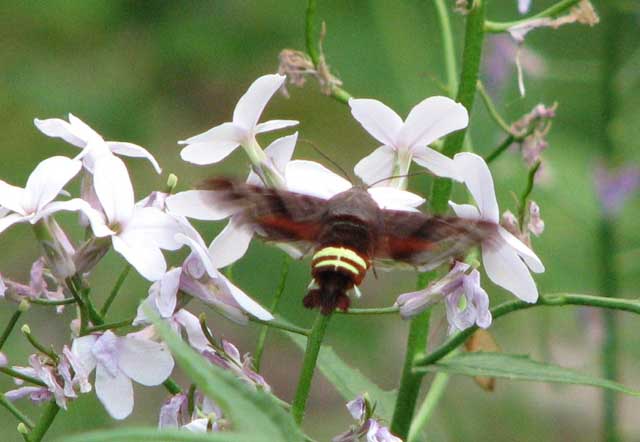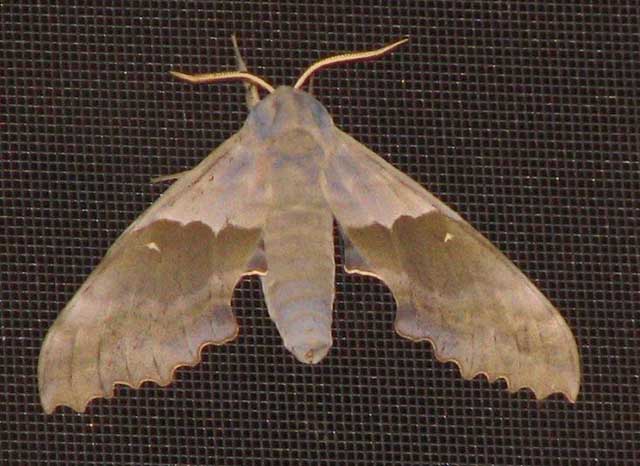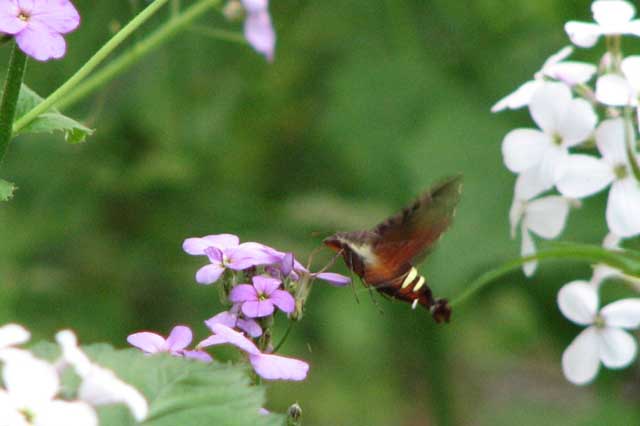Sphinginae subfamily
Sphingini tribe:
 |
Pink-spotted Hawk Moth -- Agrius cingulata WO
stray: This moth is a very strong flier, but would only make its way to
Tioga County as a rare stray. There are not too many records from
New York state, but records exist for NJ and CT.
|
 |
Ceratomia amyntor WO,
Elm Sphinx or Four-horned Sphinx.
Fw upperside: brown with dark brown and white markings including a white costal area near wing base,
dark streaks along veins, and white spot in cell. Hw upperside: light brown and has
dark brown band along outer margin.
Larvae feed on Elm (Ulmus), birch (Betula), basswood (Tilia), and
cherry (Prunus).
|
 |
Ceratomia undulosa
USGS/CW, Waved
Sphinx:
Fw upperside: pale brownish gray with wavy black and white lines and black-outlined white cell spot.
Hw upperside: gray with diffuse darker bands.
Some individuals are very dark, almost black, and others are light yellowish brown.
|
Ceratomia undulosa, Apalachin, June 7, 23, 2011; July 11, 2012, Colleen Wolpert.
 |
The upperside of the forewing is dark brown with a dusting of white scales. Some moths have patches
of reddish or yellowish brown on the wings.
|
 |
Lapara bombycoides USGS, the
Northern Pine Sphinx:
The upperside of the forewing is gray with heavy black bands. The upperside of the hindwing is
brownish gray with no markings. The underside is very plain.
Larvae of this small hawk moth feed on pines.
|
 |
Lintneria eremitus CW,
Hermit Sphinx.
Fw upperside: gray-brown with wavy lines, black dashes, and one or two small white spots near center of costa. Hw upperside:
black with two white bands and a triangular black patch at the base. Note the golden hair on the thorax.
|
Lintneria eremitus larva, September 22; adult moth, August 4, 2013; Apalachin, Colleen Wolpert.
 |
Manduca quinquemaculatus
USGS,
Five-spotted Hawkmoth.
Abdomen usually has five but sometimes six pairs of yellow
bands. Fw upperside: blurry brown and gray. The
upperside of the hindwing is banded with brown and white and has two
well-separated median zigzag bands.
|
 |
Manduca sexta
WO, Carolina Sphinx.
Abdomen usually has six pairs of yellow bands, broken across back. Sixth set quite small.
Fw upperside: indistinct black, brown, & white markings.
Hw upper banded with black & white, two black
zigzag median lines very close together with hardly any white showing between them.
Fw fringes spotted with white.
|
 | The upperside of the forewing is gray with indistinct black and
white markings. There is a series of black dashes
from the base to the tip, and a small white cell spot. North of
normal range!
|

|
Sphinx canadensis
WO,
Sphinx canadensis, Canadian Sphinx: not common, not
often reported anywhere,
but might be present in Tioga County as it is reported from
southern Ontario, Canada.
Larval hosts are white ash (Fraxinus americana), blueberry
(Vaccinium).
|
 |
Sphinx chersis
WO, Northern Ash Sphinx or Great Ash Sphinx.
Fw upperside: soft dark gray to blue-gray with a series of black dashes, one of which reaches the wing tip.
The upperside of the hindwing is black with blurry pale gray bands.
|
 |
Sphinx drupiferarum
WO, the
Wild Cherry Sphinx:
The costal area in the basal and median areas of the forewing is light grey. This colour also
appears in the terminal area. The rest of the wing is dark slatey grey.
|
 |
Sphinx gordius
WO,
Apple Sphinx:
Colouration & markings highly variable. Fw fringes mostly black with some white; those on hw mostly white
with few black patches.
Fw upperside ranges from brown with black borders through brownish gray with paler borders to pale gray with no borders.
Dashes, submarginal line, & cell spot usually weak.
|
 |
The lower forewings are predominantly brownish-yellow with a fairly wide dark bar along the inner margin. At rest the
wings hug the body, giving the moth a long slender look.
|
Sphinx kalmiae, Apalachin, July 11, 2012, courtesy of Colleen Wolpert.
 |
Sphinx luscitiosa
WO,
Canadian Sphinx or
Clemen's Sphinx:
Fw upperside: yellowish gray in males and pale gray with faint yellow tint in females. In both sexes,
dark border on outer margin widens as it approaches inner margin.
Hw upperside: deep yellow in males, pale yellow in females; both with a wide black border.
|
 |
If you have blueberries in the woods, then you probably have the
Poecila Sphinx.
|
Smerinthini Tribe:
 |
Amorpha juglandis
USGS,
the Walnut Sphinx:
The adults are highly variable; sometimes wings of an individual may be all one color or may have several colors,
ranging from pale to dark brown, and may have a white or pink tinge. Patterns range from faint to pronounced.
|
 |
Pachysphinx modesta
USGS/CW
the Modest Sphinx or Poplar Sphinx:
This moth has a large, heavy body, and females can be remarkably plump, and should be found where there
are poplars and willows, the larval hosts.
|
Pachysphinx modesta, Apalachin, May 28-29, 2011, Colleen Wolpert.
 |
Paonias excaecata
USGS, the Blinded Sphinx:
Named for the dull grey-blue spot (minus dark pupil) in the hindwing,
this moth has a wide distribution and is probably common in Tioga
County.
I regularly see them on Prince Edward Island, and they are reported
as far south as Florida. |
 |
Paonias myops USGS,
the Small-eyed Sphinx
Named for the small eye-spot in the hindwing, this moth has a wide
distribution and is probably common in Tioga County.
I regularly see them on Prince Edward Island, and they are reported
as far south as Florida.
|
 |
Tioga County would be close to the southern limit for this species in New York.
I never saw one in New Jersey. At my home in Montague, P.E.I., Canada, they are quite common.
|
 |
This moth is widely distributed and fairly common.
Along the East Coast, it flies from P.E.I. to Florida.
|
Macroglossinae subfamily
Dilophonotini tribe:
See Hemaris comparison to help distinguish
the next three species.
 |
Hemaris thysbe
WO, the Hummingbird Clearwing
This interesting day flier is reported in Broome, and
is widely reported to the north, east, south and west.
They are widely distributed in the east from P.E.I. to Florida.
|
 |
Hemaris diffinis WO/CW, the
Snowberry Clearwing or Bumblebee Moth
This moth is widespread and has been recorded in Broome County and
in northwestern N.J. and southeastern N.Y. and Connecticut.
|
Hemaris diffinis, Apalachin, May 16, 2011, Colleen Wolpert
 |
Hemaris gracilis WO, the
Slender Clearwing or Graceful Clearwing
This day-flying moth is less common and has not been recorded in
Broome, but has been seen due east, south and west. Questionable.
|
Philampelini tribe:
 |
This moth is not reported for Broome, but it is fairly often reported
along the coast from southern New Jersey
to central Maine.
Note the differences between this moth and the Pandorus Sphinx. |
 |
If you have Grape or Virginia Creeper nearby, then you probably have
this species.
I often get asked to identify larvae from areas not
previously reported. |
Macroglossini tribe:
 |
Amphion floridensis
CW,
Nessus Sphinix.
Day-flyer has two bright yellow bands on tufted abdomin. At rest, dark red-brown upperwings hide red-orange median band and
yellow spot of hindwings; in some specimens median band may be very pale or almost absent.
Concave regions of forewing outer margin also have pale yellow markings in fringe area.
|
Amphion floridensis, Apalachin, Colleen Wolpert
 |
The lower wings of this hawkmoth are a solid brownish-orange, matching the body colour.
|
 |
Darapsa myron
USGS, Virginia Creeper Sphinx or Grapevine Sphinx:
Fw upperside: dark brown to pale yellowish gray, with olive tint. Forewing color often quite.
On costal margin there is a dark rectangular patch, although this may be reduced or absent. Hw upperside is pale orange.
|
 |
Darapsa versicolor
WO,
the Hydrangea Sphinx.
The forewing upperside is often greenish brown with curved dark lines and pinkish-white patches.
The hindwing upperside is pale yellow to reddish brown with white along the costal margin, greenish brown
along the outer margin, and white shaded with greenish brown on the inner margin.
|
 |
Deidamia inscriptum
USGS,
Lettered Sphinx:
The moth's outer margin of the forewing is deeply scalloped.
Upperside light brown with dark brown markings.
There is small black and white spot near the tip.
Hw upperside: orange-brown with a dark brown outer margin and median line.
|
 |
Hyles gallii
WO/CW, the Bedstraw Hawk Moth
or Gallium Sphinx
This forewing is dark brown with a slightly irregular cream-coloured transverse line.
The outer margin is grey. There is a bright pink band on the hindwing.
|
Hyles gallii, Apalachin, August 15, 2010; June 4, 2011; Colleen Wolpert
 |
Hyles lineata USGS, White-lined Sphinx
Fw upperside: dark olive brown with paler brown along the costa and outer margin, narrow tan band running from wing tip to base,
and white streaks along the veins.
The hindwing upperside is black with a reddish pink median band.
|
 |
Sphecodina abbottii
WO,
Abbott's Sphinx:
Adults mimic bumblebees, making buzzing sound when feeding. Wing margins are scalloped.
Fw upperside: dark brown with light brown bands and markings. The upperside of the hindwing is yellow with a wide black outer margin.
|
|
|




